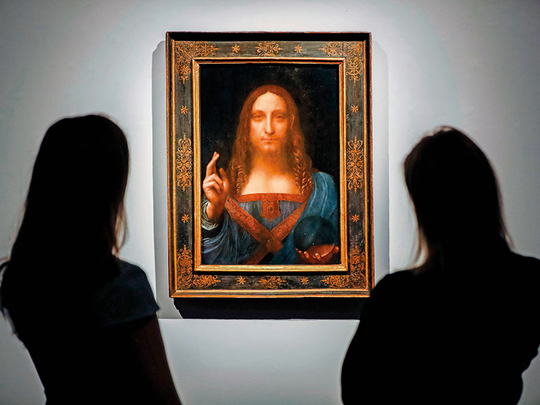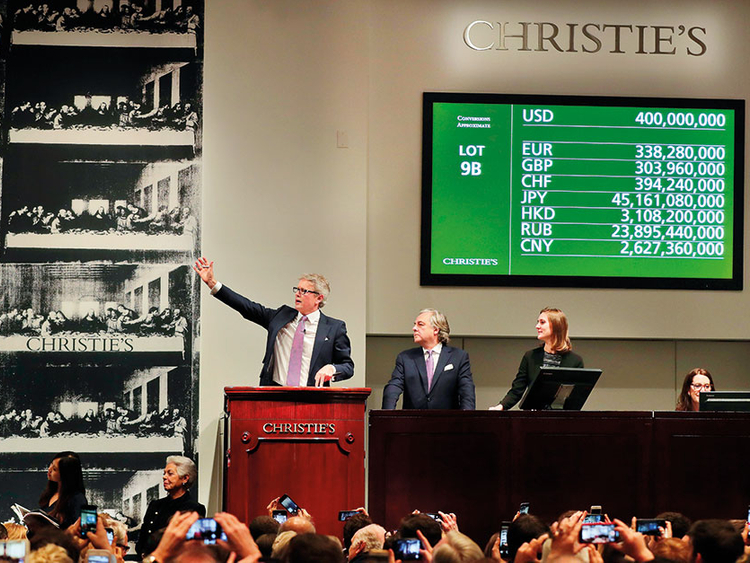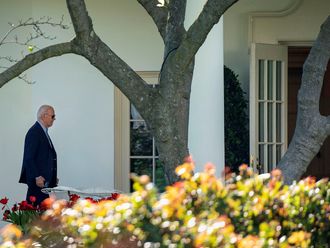
NEW YORK: Leonardo da Vinci’s “Salvator Mundi,” considered either the most important old master work to be auctioned in a generation or a damaged painting hyped by savvy marketing, sold on Wednesday night for $450.3 million with fees, a record for any work of art sold at auction. It far surpassed the sale of Picasso’s “Women of Algiers,” which fetched $179.4 million at Christie’s in May 2015.
As a telephone bidder pondered the next increment, Jussi Pylkkanen, the auctioneer, said, “It’s a historic moment: We’ll wait.”
The price is all the more remarkable at a time when the old masters market is contracting, because of limited supply and the penchant of collectors for contemporary art.
But to critics, the astronomical sale attests to something else - the degree to which the salesmanship has come to drive and dominate the conversation about art and its value. Christie’s marketing campaign was perhaps unprecedented in the art world; it was the first time the auction house went so far as to enlist an outside agency to advertise the work, creating a video that includes top executives pitching the painting to Hong Kong clients as “the holy grail of our business” and likening it to “the discovery of a new planet.”
“It’s been a brilliant marketing campaign,” said Alan Hobart, director of the Pyms Gallery in London, who has acquired museum-quality artworks across a range of historical periods for the British businessman and collector Graham Kirkham. “This is going to be the future.”
To the 27,000 people who lined up at pre-auction viewings in Hong Kong, London, San Francisco and New York to glimpse the painting of Christ as “Savior of the World,” this was merely the chance to lay their eyes on what Christie’s billed as “the last da Vinci,” the only known painting by the Renaissance master still in a private collection (some 15 others are in museums).
Members of the public - indeed, even many cognoscenti - cared little if at all whether the painting might have been executed in part by studio assistants; whether Leonardo had actually made the work himself; or how much of the canvas had been repainted and restored. They just wanted to see a masterpiece that dates from about 1500 and was rediscovered in 2005.
“There is extraordinary consensus it is by Leonardo,” said Nicholas Hall, the former co-chairman of old master paintings at Christie’s, who now runs his own Manhattan gallery. “This is the most important old master painting to have been sold at auction in my lifetime.”
That is the kind of name-brand appeal that Christie’s was presumably banking on by placing the painting in its high-profile contemporary art sale, rather than in its less sexy annual old master auction, where it technically belongs. To some extent, the auction house succeeded with the painting even before the sale, having secured a guaranteed $100 million bid from an unidentified third party.
It is the 12th painting to break the $100 million mark at auction, and a new high for any old master at auction, surpassing Rubens’ “Massacre of the Innocents,” which sold for $76.7 million in 2002 (or more than $105 million, adjusted for inflation).
But many art experts argue that Christie’s used marketing gymnastics to mask the baggage that comes with the Leonardo, from its compromised condition to its complicated buying history and said that the auction house put the artwork in a contemporary sale to circumvent the scrutiny of old masters experts, many of whom have questioned the painting’s authenticity and condition.
“The composition doesn’t come from Leonardo,” said Jacques Franck, a Paris-based art historian and Leonardo specialist. “He preferred twisted movement. It’s a good studio work with a little Leonardo at best, and it’s very damaged.”
“It’s been called ‘the male Mona Lisa,’” he said, “but it doesn’t look like it at all.” Franck said he has examined the Mona Lisa out of its frame five times.
Luke Syson, curator of the 2011 National Gallery exhibition in London that featured the painting, said in his catalog essay that “the picture has suffered.” While both hands are well preserved, he said, the painting was “aggressively over cleaned,” resulting in abrasion of the whole surface, “especially in the face and hair of Christ.”
Christie’s maintains that it was upfront about the much-restored, damaged condition of the oil-on-panel, which shows Christ as savior of the world, his right hand raised in blessing and his left holding a crystal orb.
But Christie’s was also slow to release an official condition report and its authenticity warranty on Leonardo runs out in five years, according to the small print in the back of its sale catalog.
The auction house has also played down the painting’s volatile history.
The artwork has been the subject of legal disputes and amassed a price history that ranges from less than $10,000 in 2005, when it was spotted at an estate auction, to $200 million when it was first offered for sale by a consortium in 2012. But no institution besides the Dallas Museum of Art, which in 2012 made an undisclosed offer on the painting, showed demonstrated public interest in buying the painting.













